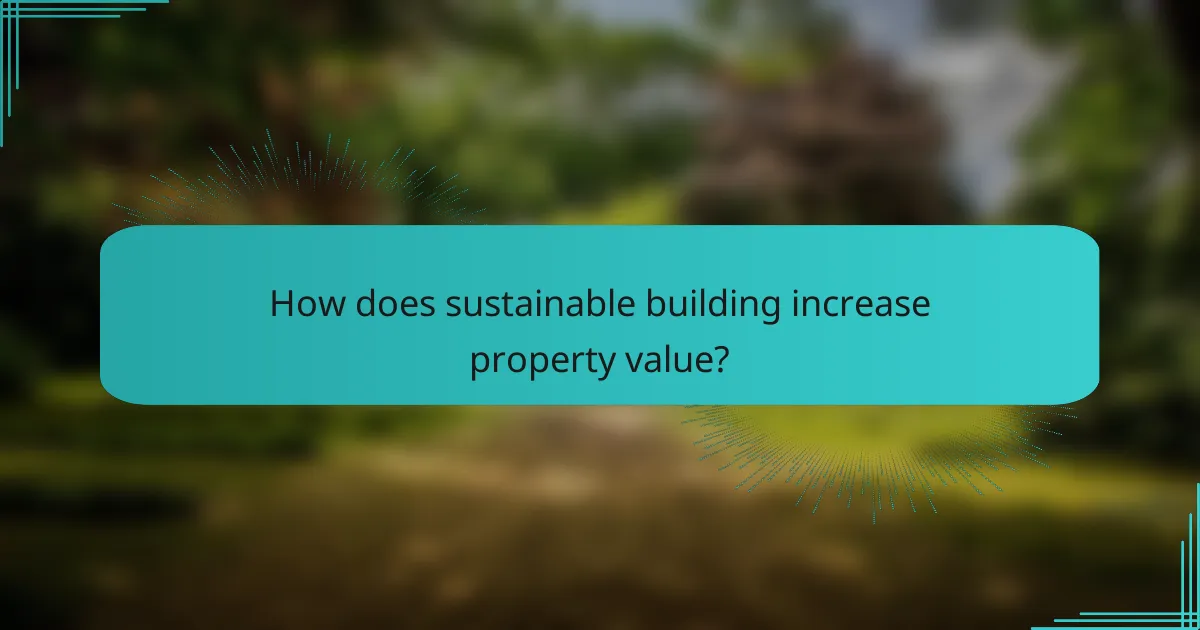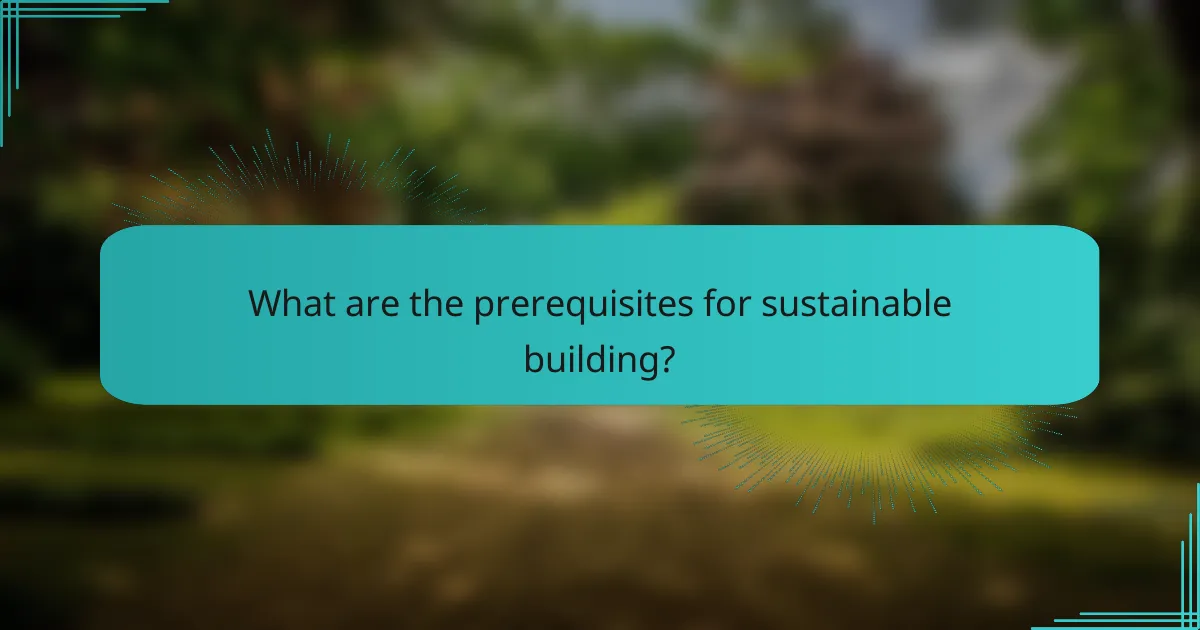Sustainable building practices in Australia provide numerous benefits, including substantial energy savings, improved occupant health, and increased property values. By utilizing energy-efficient materials and designs, these structures not only reduce utility costs but also foster healthier living environments through better air quality and natural lighting. Ultimately, investing in sustainable buildings enhances both the quality of life for residents and the market appeal of properties.

What are the benefits of sustainable building in Australia?
Sustainable building in Australia offers significant advantages, including energy savings, enhanced occupant health, and increased property value. These benefits not only contribute to environmental sustainability but also improve the quality of life for residents and the overall marketability of properties.
Energy savings through efficient design
Efficient design in sustainable buildings leads to substantial energy savings by optimizing resource use. Features such as high-performance insulation, energy-efficient windows, and renewable energy systems can reduce energy consumption by a considerable margin, often achieving reductions of 30% or more compared to traditional buildings.
Incorporating passive solar design, which harnesses natural light and heat, can further enhance energy efficiency. This approach minimizes reliance on artificial heating and cooling, resulting in lower utility bills and a reduced carbon footprint.
Improved occupant health and comfort
Sustainable buildings prioritize occupant health by using non-toxic materials and ensuring good indoor air quality. This focus on health can lead to fewer respiratory issues and allergies among residents, contributing to overall well-being.
Additionally, sustainable designs often include better natural ventilation and daylighting, which enhance comfort and productivity. Access to natural light has been shown to improve mood and reduce stress, making sustainable buildings more appealing to occupants.
Increased property value over time
Properties built with sustainable practices typically experience higher market values due to their energy efficiency and health benefits. Buyers are increasingly seeking homes that reduce long-term operating costs and provide a healthier living environment.
Moreover, as sustainability becomes a priority in Australian real estate, properties that meet green building standards may qualify for incentives or higher resale values. Investing in sustainable features can yield a return on investment that outpaces traditional building methods over time.

How does sustainable building reduce energy costs?
Sustainable building reduces energy costs primarily by incorporating energy-efficient practices and materials that lower consumption. By optimizing energy use, these buildings can significantly decrease utility bills and enhance overall efficiency.
Utilization of renewable energy sources
Integrating renewable energy sources, such as solar panels or wind turbines, allows buildings to generate their own electricity, reducing reliance on traditional energy grids. This can lead to substantial savings on energy bills, especially in regions with high electricity costs.
For example, a solar panel system can offset a significant portion of a building’s energy needs, potentially covering 50% or more of its consumption, depending on location and system size. Additionally, many governments offer incentives or tax credits for renewable energy installations, further enhancing financial benefits.
Enhanced insulation and energy-efficient materials
Improved insulation and the use of energy-efficient materials play a crucial role in minimizing energy loss. High-quality insulation keeps buildings warmer in winter and cooler in summer, reducing the need for heating and cooling systems to work as hard.
Common materials like insulated concrete forms (ICFs) or energy-efficient windows can improve energy performance by 20% to 30%. Investing in these materials not only lowers energy costs but can also qualify a building for green certifications, which may increase property value.

What impact does sustainable building have on occupant health?
Sustainable building significantly enhances occupant health by promoting better indoor environments. This is achieved through improved air quality, natural lighting, and the use of non-toxic materials, all of which contribute to overall well-being.
Better indoor air quality
Improved indoor air quality is a hallmark of sustainable buildings, often achieved through proper ventilation and the use of low-VOC (volatile organic compounds) materials. These practices help reduce allergens, pollutants, and harmful chemicals, leading to fewer respiratory issues and allergies among occupants.
To ensure optimal air quality, consider incorporating mechanical ventilation systems that meet ASHRAE standards, which can significantly enhance air exchange rates. Regular maintenance of HVAC systems is crucial to prevent the buildup of dust and mold.
Natural lighting and its effects on well-being
Natural lighting plays a vital role in enhancing occupant well-being by regulating circadian rhythms and improving mood. Buildings designed with large windows, skylights, and open layouts can maximize daylight exposure, reducing the need for artificial lighting and lowering energy costs.
To optimize natural light, consider the orientation of the building and the placement of windows. Aim for spaces that receive ample sunlight during the day, which can lead to increased productivity and a more pleasant living environment.

How does sustainable building increase property value?
Sustainable building increases property value by enhancing energy efficiency, improving occupant health, and appealing to a growing market of eco-conscious buyers. Properties designed with sustainability in mind often command higher prices due to their lower operational costs and increased desirability.
Attractiveness to eco-conscious buyers
Eco-conscious buyers are increasingly prioritizing sustainability when making purchasing decisions. Features such as energy-efficient appliances, renewable energy sources, and sustainable materials can make a property more appealing, leading to quicker sales and potentially higher offers.
In markets where environmental awareness is high, properties with green certifications, like LEED or BREEAM, can stand out significantly. These certifications not only demonstrate a commitment to sustainability but also provide assurance of quality and efficiency to prospective buyers.
Long-term savings appealing to investors
Investors are drawn to sustainable buildings due to their potential for long-term cost savings. Energy-efficient designs can reduce utility bills significantly, often by 20-30%, which translates to higher net operating income over time.
Additionally, sustainable buildings tend to have lower maintenance costs and longer lifespans, making them a sound investment. Properties that incorporate green technologies may also benefit from tax incentives or grants, further enhancing their financial appeal.

What are the prerequisites for sustainable building?
Sustainable building requires a clear understanding of local regulations, the selection of eco-friendly materials, and a commitment to energy efficiency. These prerequisites ensure that the construction process not only meets legal standards but also contributes positively to the environment and occupant well-being.
Understanding local building codes in Australia
In Australia, local building codes dictate the standards for construction, including sustainability requirements. Builders must familiarize themselves with the National Construction Code (NCC) and any state-specific regulations that promote energy efficiency and environmental responsibility.
Compliance with these codes often involves meeting minimum energy performance standards, which can include insulation requirements, energy-efficient windows, and the use of renewable energy sources. Checking with local councils can provide additional insights into specific regulations that may apply to your project.
Choosing the right sustainable materials
Selecting sustainable materials is crucial for reducing the environmental impact of a building. Look for materials that are locally sourced, have low embodied energy, and are recyclable or biodegradable. Common choices include bamboo, reclaimed wood, and recycled metal.
Consider certifications such as Green Star or the Global GreenTag, which indicate that materials meet certain environmental standards. Using these materials not only supports sustainability but can also improve indoor air quality and occupant health.

What are the emerging trends in sustainable building?
Emerging trends in sustainable building focus on enhancing energy efficiency, improving occupant health, and increasing property value. These trends reflect a growing awareness of environmental impacts and the benefits of creating healthier living spaces.
Integration of smart home technology
Smart home technology plays a crucial role in sustainable building by optimizing energy usage and enhancing comfort. Systems such as smart thermostats, lighting controls, and energy monitoring devices help occupants manage their energy consumption effectively.
For instance, smart thermostats can learn user preferences and adjust heating and cooling automatically, potentially reducing energy bills by 10-20%. Homeowners should consider integrating these technologies during the construction phase for seamless operation.
Use of recycled materials in construction
Utilizing recycled materials in construction minimizes waste and reduces the demand for new resources. Commonly recycled materials include reclaimed wood, recycled metal, and repurposed concrete, which can significantly lower the carbon footprint of a building project.
When selecting materials, builders should look for certifications that verify the recycled content, such as the Cradle to Cradle certification. This approach not only supports sustainability but can also enhance the aesthetic appeal of the property.
Focus on biophilic design principles
Biophilic design emphasizes the connection between nature and the built environment, promoting occupant well-being and productivity. Incorporating natural elements like plants, natural light, and water features can create a calming atmosphere and improve indoor air quality.
Designers should consider using large windows, green walls, and indoor gardens to enhance this connection. Research indicates that biophilic design can lead to increased property values and higher tenant satisfaction, making it a worthwhile investment for developers.


